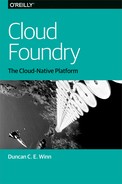Chapter 6. Summary
“We excel at focusing on the things that only we can do, which means leaving certain things to others who excel at what THEY do; this is why we work with Cloud Foundry.”
Harel Kodesh, CTO of GE Digital
This book has explored a number of technical driving forces impacting software development and delivery. These driving forces are far more than hype; they provide intrinsic value. To recap:
-
Agile is not just the adoption of stories and scrums. It involves a completely different approach from the traditional waterfall development model, with the most critical element being rapid feedback from end users.
-
Continuous delivery is not about automation for the sake of reducing cost. It is about ensuring that repeatable, tested, and integrated releases can be placed in the hands of the consumer when required, rather than waiting for an annual release cycle.
-
Microservices are not merely about delivering smaller services. They are about faster development of more modular applications with the freedom to be decoupled in development and connected in deployment.
-
Cloud-native applications do not simply mean applications running on an IaaS. They are applications designed to thrive and move at will in an ephemeral and highly distributed environment.
If the preceding trends are actively contrasted with traditional enterprise IT, one thing becomes clear. Most teams are full of very talented individuals who, collectively, are a long way from moving at the required pace of change. Companies that cannot deliver software at the required cadence need to fundamentally change the way they build and deploy software in order to succeed in the hugely competitive markets that exist today. These companies need to become cloud native.
Becoming Cloud Native
We have discussed becoming cloud native as an imperative for delivering applications with velocity. Becoming cloud native involves adopting three key elements:
-
Self-service, on-demand, and elastic infrastructure
-
Cloud-native platforms
-
Cloud-native / Twelve Factor applications
Adopting these three elements provides the capabilities required for:
-
Repeatedly delivering software into production with velocity
-
Establishing a timely development-feedback cycle
Cloud-native platforms have become essential for adapting to the aforementioned IT trends. They are focused on making the software build, test, deploy, and scale cycle significantly faster. They achieve this by removing many of the hurdles involved in deploying software, enabling you to release software at will. In short, Cloud Foundry does more on your behalf, purposefully allowing enterprises to refocus engineering effort back into the business. This is beneficial; the less you are required to do, the higher your velocity will be.
Why Cloud Foundry?
Cloud Foundry is an opinionated, structured cloud-native platform that imposes a strict contract between the infrastructure layer underpinning it and the applications and services that it supports. This allows for cloud-native applications to be run predictably and reliably across different infrastructures.
Cloud Foundry is an open platform, allowing for a choice of underlying infrastructure, polyglot developer languages and frameworks, and a rich array of application services. In addition, Cloud Foundry is open sourced and governed by a multi-organization foundation. The diversity, strength, and value of this community should not be underestimated. It is a powerful thing when different technology companies, industries, and lines of business collaborate with such strong cohesion and momentum.
Enabling the Fundamental Shift
Business value is no longer sustainable by maintaining a process to support an established competitive advantage. Markets and business climates are changing too rapidly for this approach to be sustainable. Specifically, established markets are being repeatedly disrupted by software. Technology is constantly evolving, and businesses are under relentless pressure to adopt the myriad of technical driving forces impacting software development and delivery.
These driving forces are all focused on enabling organizations to ship software with velocity; velocity is paramount to establishing a competitive advantage. Companies need to adapt to these driving forces—constantly evaluating, adopting, and incorporating the necessary technologies, development methodologies, and architectural styles—in order to remain competitive.
Ongoing competitive advantage is established through delivering software repeatedly, with velocity, through iterative development cycles of short duration, resulting in a constant feedback loop from end users.
Technology alone, however, has never been enough. Companies need to fundamentally change the way they build and deploy software. Velocity is achieved by making the necessary technical changes along with changes to established process, organization, and culture. The effect of achieving this change is that business can move at a phenomenal pace. Moving at pace enables companies to react to shifting demand and focus on the key areas receiving the most customer traction. Ultimately, it produces software that aligns tightly with user expectations. This is your new competitive advantage.
Cloud Foundry, with the backing of a vibrant open source community and an established foundation nearing 60 companies, is arguably one of the most important open source projects in existence today.
For those companies desiring to achieve velocity and establish a development-feedback cycle—and for those companies challenged with responding to the technical driving forces relentlessly shaping today’s marketplaces—Cloud Foundry, as an established cloud-native platform, provides the most compelling way to enable the fundamental shift in the way we build and deploy software.
